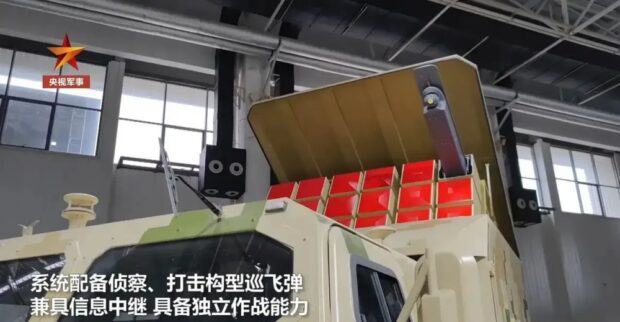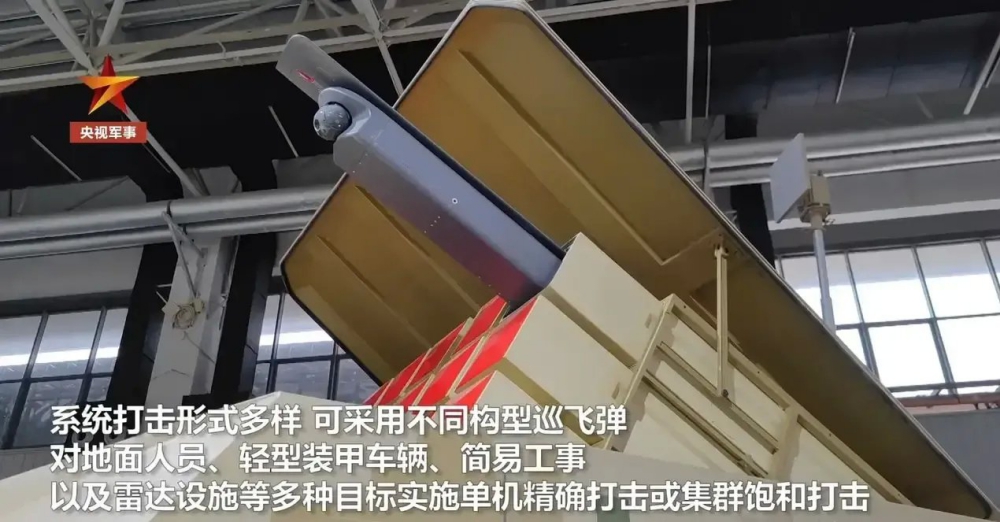Among the several intriguing concepts and technologies being teased ahead of this year’s Zhuhai Air Show in China is a light vehicle-mounted swarm launcher that will seemingly be capable of launching up to 18 drones.
The capability is largely reminiscent of a system tested by the Chinese in 2020, which underscores the speed at which the ever-growing arsenal of weaponized drone systems in China is iterating.
A brief clip of the unnamed drone swarm system was aired by the CCTV state television station in a segment meant to preview the types of capabilities that will be showcased at China’s 2022 Zhuhai Air Show. According to a machine translation of captions from the video, the launcher is being developed by the China Ordnance Equipment Group (COEG).
Also sometimes referred to as China South Industries Group Corporation, the company is a Chinese state-owned manufacturer of both civilian and military technologies that are produced for domestic and international customers. The video stated that the 2022 Zhuhai Air Show is going to be the first-ever event where the system will be exhibited.
Based on the machine translations, the system is designed to serve as a light and highly maneuverable loitering drone swarm launcher. The munitions come in individual launch canisters for easy reloading and are said to be available in both information-gathering and attack configurations. This would allow the system to perform in the various core mission sets outlined by CCTV including reconnaissance, area control, damage assessment, precision strike, and cluster strike saturation attacks.
When equipped with an explosive charge, CCTV explained that the drones would be ideal for striking ground personnel, light armored vehicles, simple fortifications, and other high-value targets such as radar facilities.
Two of the unidentified loitering munitions, or mockups thereof, that this system will ostensibly be capable of launching can be seen in the footage. One is on display with its wings popped out beside the vehicle and one extends out from inside a launch tube with its wings retracted.
A gimballed sensor turret can also be seen on the nose of the drone that is displayed. This would provide a remote video feed for reconnaissance and targeting. A mix of drones loaded with different payloads, from warheads to electronic surveillance measures to video surveillance to jammers would be ideal for employing a swarm-like capability against a complex target set.
When compared to, for example, the Israeli-made Mini Harpy produced by IAI or the U.S.-designed Switchblade loitering munition manufactured by AeroVironment, the drones that can be seen in the CCTV clip have clearly adopted similar physical characteristics. The drones’ narrow body, pop-out wings, and V-shaped tail appear to take after these designs in some capacity especially considering how this kind of foldable main wing is a relatively common configuration for canisterized drones. Regardless, the similarities to these existing systems could at the very least hint at how COEG’s drones may perform in combat.
The highly mobile vehicle, which would be capable of quickly relocating in a ‘shoot-and-scoot’ fashion depending on the needs of the mission, looks to be your average light tactical vehicle. Aside from CCTV reporting that it is capable of adapting to a variety of terrain situations, not much else can be gathered about the vehicle itself or the technologies that could equip it aside from a raised sensor mast that can be seen extending up from the launcher mounted to its back.
The mast is a critical part of a system like this as it would provide much better line-of-sight connectivity with the drones and the truck. While the drones could be programmed to hit a static target autonomously or possibly to fly a certain route and return with reconnaissance data, without a line-of-sight link the drones cannot be dynamically employed and targeting on the fly is not an option.
Although, the vehicle does look quite a bit like a Dongfeng Menghsi 6×6 variant that China has used to mobilize drone launchers in the past. In 2020, China conducted a test with what, on a core level, appeared to be a more unrefined version of COEG’s new swarm launcher system.
The China Academy of Electronics and Information Technology held the demonstration, which employed the 6×6 version of the Dongfeng Mengshi light tactical vehicle mounted with a drone launcher that featured a whopping 48 launch tubes as opposed to 18. However, the older design used completely different drones similar to China Poly Defense’s CH-901s, which may later prove to mean that COEG’s design could be configured to fire other types of drones, too. This would make sense considering what looks like a modular payload bay that may accommodate different-sized canisters.
Additional details about this system and the drones it could fire were just as limited in 2020 as they are now with COEG’s contribution, but the same basic points apply. Even though it is unclear if China and its People’s Liberation Army actually possess an operational drone swarm capability identical to or modeled after these systems, the demonstrations and the displays still communicate that drone swarm technologies are very much becoming a reality and thereby a threat.
Source: The Drive


